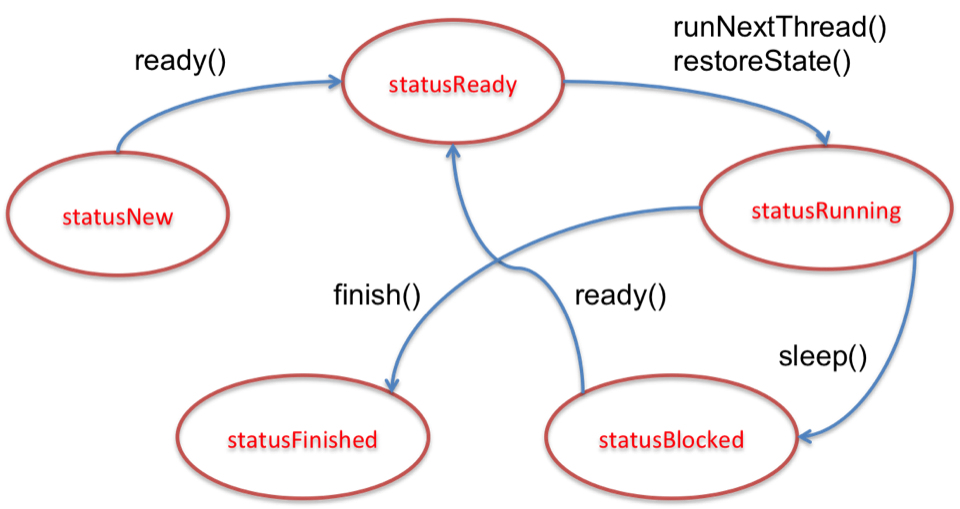
All Nachos threads are instances of nachos.threads.KThread (threads capable of running user-level MIPS code are a subclass of KThread, nachos.userprog.UThread). A nachos.machine.TCB object tcb is contained by each KThread object and provides low-level support for context switches, thread creation, thread destruction, and thread yield.
Every KThread has a status member that tracks the state of the thread. Certain KThread methods will fail (with a Lib.assert()) if called on threads in the wrong state. The life cycle of KThread is illustrated in Figure 26.
Internally, Nachos implements threading using a Java thread for each TCB object. The Java threads are synchronized by the TCBs such that exactly one is running at any given time. This provides the illusion of context switches saving state for the current thread and loading the saved state of the new thread. For the understanding of KThread, we can focus on its public methods.
The life cycle of a KThread object starts when it is created. The first KThread is created in the initalize method of ThreadKernel:
The constructor for KThread follows the following procedure the first time it is called:
After this procedure, there are two KThread objects, each with a TCB object (one for the main thread, and one for the idle thread). The main thread is not special - the scheduler treats it exactly like any other KThread. The main thread can create other threads, it can die, it can block. The Nachos session will not end until all KThreads finish, regardless of whether the main thread is alive.
For the most part the idle thread is also a normal thread, which can be context switched like any other. The only difference is it will never be added to the ready queue (KThread.ready() has an explicit check for the idle thread). Instead, if readyQueue.nextThread() returns null, the thread system will switch to the idle thread.
If the current thread exists, calling the constructor for KThread with a Runnable object will simply create a new TCB object with the default status statusNew. Note that the KThread object is not yet added to the ready queue until its KThread.fork() method is called. KThread.fork() causes the Java thread by the associated TCB object to begin execution and calls the KThread.ready() method, which puts the KThread object in the ready queue.
Note that KThread.fork() differs from Unix fork system calls, which returns twice, once in the parent process and once in the child process. KThread.fork() only serves to prepare the associated KThread for scheduling.
Other public KThread methods related to the thread life cycle include, KThread.run(), KThread.sleep(), KThread.yield(), KThread.finish(), KThread.join():
The main thread is blocked and would not reach line 19 until both threads finish. Since a current thread cannot join itself, in KThread.join(), this thread (the callee) should be different from the current thread (the caller). In the thread and synchronization project, you will be asked to complete the implementation of KThread.join().